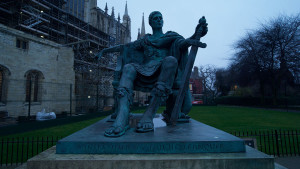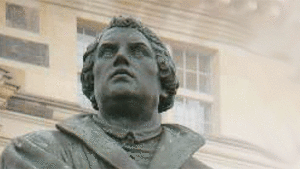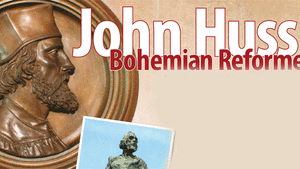With those vivid, quaintly spelled words, the Bishop of London justified the martyrdom of reformers in England during the reign of Mary Tudor (1553-58). Mary lived in obscurity until the death of “the godly imp” Edward VI, her half-brother. Of the many earnest believers burned as heretics by “Bloody Queen Mary,” we remember most of all four of the men who died during 1555-56: Thomas Cranmer, Hugh Latimer, Nicolas Ridley and John Hooper.
However, uncounted others made the supreme sacrifice as “slowly in a shambling sort of way”—to use Vivian Green's expression—a new English church emerged by the time of Elizabeth I (1558-1603). “You have the Word,” one of Mary's supporters boasted, “we have the Sword.” The sword was sharp and cruel, but the Word won after a long and painful struggle.
a great need: the Word
One of the greatest needs of Christianity in England during the 16th century was for a better translation of the Bible, one that spoke to ordinary men and women as well as to preachers and scholars. The authors of the New Testament used the language commonly heard in homes and marketplaces to express divine truths.
The Jewish rabbi (teacher) we call the apostle Paul knew that his letters would be far less effective if his ideas were imprisoned in the esoteric beauty of classical Greek, so even he used ordinary (Koine) Greek.
Then, as missionary movements brought the message of Jesus to new nations, such as those in Europe, Afri ca and Asia, there was a constant need to translate God's Word for people who knew nothing of either Hebrew (Old Testament) or Greek (New Testament), the original languages in which the 66 sacred books were first written.
Latin translations widened the influence of the Bible, especially while the Roman Empire was influential or educated people cherished classical learning.
John Wycliffe (died 1384) took a huge step toward meeting the need of English-speaking people when he translated the Scriptures from Latin into English, but within 100 years Wycliffe's language needed updating.
Not until the 17th century was a version of the Bible published in such excellent English that it would last for centuries.
In fact, even now many Englishspeaking Christians still cherish the “Authorised” or King James Version (KJV). Most of us know little about King James I, except we recall that it was “by his Majesties Speciall Commandement” that the KJV was issued in 1611.
In many respects the Protestant Reformation was initiated by Bible study among its leaders like Luther, Calvin, Cranmer and Knox, but it was sustained because of a wider availability of the Scriptures in the diverse languages of ordinary believers. The effect was not only spiritual, of course; it had many cultural dimensions.
Owen Chadwick notes in A History of Christianity: “In every country of Protestant Europe, the translation of the Bible deeply affected both literature and everyday language. A fine English translation of the New Testament and parts of the Old Testament was made during the reign of Henry VIII by William Tyndale, who was obliged to hide on the continent of Europe and was later betrayed and strangled. It was adapted from time to time, and eventually formed the basis of the much-loved ‘Authorised Version' or ‘King James Bible' of 1611.”
debt to Tyndale and Cranmer
The language of devotion and worship currently used in Australia and New Zealand in 2007 owes an enormous debt to two of the men who were reduced to ashes in 1536 and 1556.
Cranmer created much of the language of faith enshrined in The Book of Common Prayer; some of his phrases are familiar even to casual Christians who only attend church to celebrate “hatches, matches and dispatches” (baptisms, weddings and funerals). Since Tyndale influenced Cranmer and the entire English-speaking world through his translation of the Bible, we do well to give attention to this man of faith who was so violently treated.
William Tyndale was born about 1494 in Gloucestershire and spent five years studying at Oxford University before additional study at Cambridge.
By the early 1520s, a bold plan was forming in his mind: he determined to create a fresh translation of the Bible, not from Latin but from the original languages, beginning with the New Testament.
According to the Bishop of London, this was not an acceptable idea. For a time, London merchants such as Humphrey Monmouth supported him, but it became necessary for Tyndale to flee England, never to return. Sheltering in Hamburg, Tyndale had his first translation ready for printing in Cologne by 1525. Even though local magistrates interrupted the process there, the work was printed in Worms and reached England the next year to be bitterly attacked, collected and burned by the Bishop of London and others.
The fugitive moved to the English House in Antwerp, continuing his writing and, especially, the constant revision of his New Testament. By 1530, Tyndale had also translated the first five books of the Old Testament; much more of it was in manuscript form before he was betrayed, arrested, imprisoned, strangled and burned at the stake on or about October 6, 1536.
a martyr's witness
Tyndale understood the Greek and Hebrew in which the original authors told the story of salvation; his genius was to express Scripture in “straightforward, vigorous English,” according to The Oxford Dictionary of the Christian Church.
So winsome was Tyndale's language that, although many others would attempt their own translations or revise Tyndale's work, his translation formed the basis for the most-cherished English Bible, the Authorised Version, and its major offspring, the Revised Version made in England and North America between 1870 and 1884. What might he have accomplished had he been permitted to live a normal life span? Three almost complete copies of Tyndale's 1526 New Testament printed in Worms are known to exist. Some years ago the British Library bought one of them from the Baptist College of Bristol for







